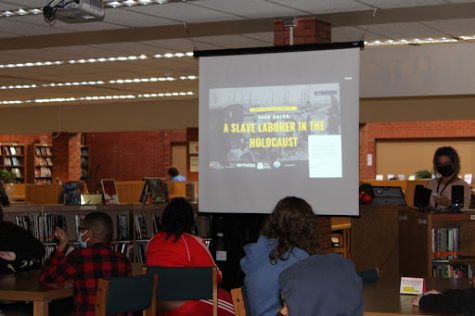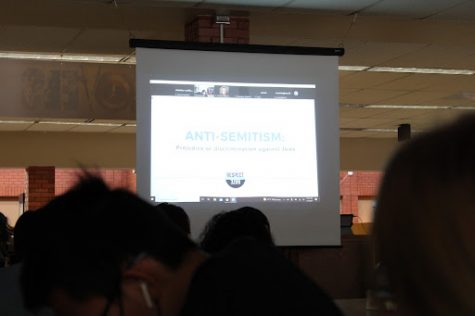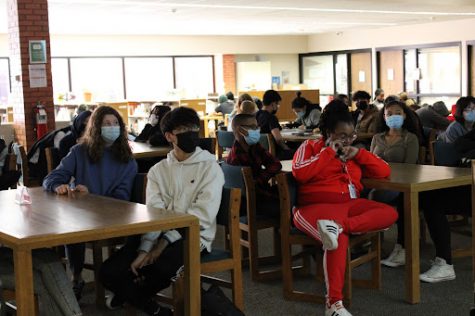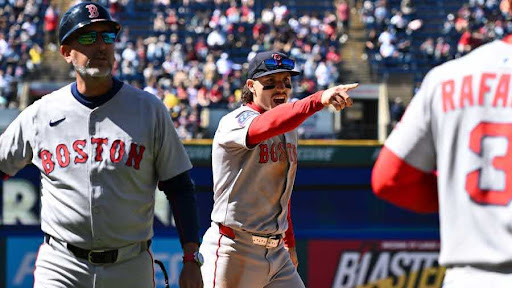Escaping Hitler’s Iron Fist
On Wednesday, Jack Adler, a surviver of the Holocaust “presented” to the Eaglecrest library. Here is his story:

Those without blonde hair and blue eyes were those who Hitler decided the world did not need. Jack Adler, among thousands of other Jewish people just like him, was just one victim of the Holocaust. Adler was lucky enough to survive, and Eaglecrest was lucky enough to hear his story.
Adler was born in Poland in 1929, just ten years before the Nazi invasion of his hometown, Pabianice. Although it was most extreme during the Holocaust, Anti-Semetic attitudes were introduced in mainstream Europe immediately after WW1.
Growing up, Adler remembers facing anti-semitism as a child.
“Most of the time, [the Jewish and non-Jewish kids] got along well. However, I recall, on Christian holidays, such as Easter and Christmas, There was a lot of expression of hatred for Jewish kids,” he said. “We were called ‘Christ-killers,’ they would chase us around, and throw stones at the roof. I remember my mother would dread the time I would step outdoors during those holidays.”

Unfortunately, the name calling and prejudice did not satisfy one man, who hated the Jewish enough to start a world war. Adolf Hitler changed the world, infamously. Though he may be long gone, what he did will never be erased.
“As a soldier in WWI, Adolf Hitler had been carried along by the increasingly vicious political anti-semitism, which seeped into the military hierarchy during the last two years of [WWI]” said Penny Nisson, Director of Education at the Mizel Museum, the organization who brought Adler’s presentation to us. “After the Nazis came to power in Germany, they effectively used propaganda to win the support of millions of Germans to help facilitate persecution, war, and ultimately genocide.”
Leading up to WWII, Adler’s community was hearing about what was happening in Germany. But no amount of information could have prepared them for what they were about to go through.
“Two months before World War II, [in] September 1939, there were a lot of rumors going around [about] what was going on in Germany. I had no direct conversations with anyone– I could only hear adults talk about it, or even my mother and father talked about it. The Jewish population, of course, became fearful. And this was prior to Hitler declaring war on Poland,” Adler said.
As someone who was very explicitly affected by Hitler and his heinous acts, Adler has an interesting perspective on the man and why he did what he did.
“When you perpetuate a hatred towards a people–which is condemned by Church and state–you first stereotype that group of people, in this case the Jewish people, then dehumanize them, and then you demonize them. It’s very easy for those who have grown up in such an environment to view the political [scapegoat] as useless people who shouldn’t live,” he continued. “In my opinion, Hitler, did not create the world–the world created Hitler, because he was a part of this environment.”

Hitler’s goal was to create a “perfect” Europe– one without Jewish people.
“The Nazi government enacted hundreds of increasingly anti-semitic and restrictive laws that banned Jews from all aspects of German public life. Overall, the ability to make a living was taken away from the Jews. They were ordered out of their homes, only allowed to take one bag of belongings and forced into the ghettos. Nazis began to systematically target Jews in all the territories invaded, including Poland,” said Nisson.
When Adler’s hometown was occupied in September 1939, Adler’s life changed very quickly. He stayed up to see the flashlights of the Polish army retreating at night, and woke up to his father and older brother’s decision to leave Pabianice. At the time, half of Poland was also occupied by Russia. Adler’s father and brother hoped to find refuge on the Russian side, but returned home after about five days because they were kept out. Meanwhile, Hitler had been taking Jews to work as slaves in the ghettos.
“We didn’t know anything until finally we got put into a ghetto–then, we realized that it was a gradual step-by-step plan to exterminate the Jewish people.”
In the ghettos, people were divided into two groups: those who lived and those who died.
“Group A were those who the Nazis deemed ‘useless eaters’ couldn’t perform, dare I say, slave labor. Group A was the sick, the old– my little sister was in group A. My father, my older sister and I were in Group B, whom the Nazis deemed as able-bodied men and women who could still perform slave labor for them; therefore, they could go on living a little bit longer,” testified Adler.

I will leave you with one of Adler’s most powerful stories his life as a slave in the ghettos during the Holocaust:
“[One night], at about 9:00, a couple of Nazi officers came up to Group B and asked for volunteers to pick up the debris that was left behind by those from Group A, like articles of clothing and pieces of paper. Hoping to see my little sister again, I volunteered. Each volunteer was given a baby carriage. I slowly moved from Group B towards Group A, picking up pieces of paper [and] articles of clothing, [trying] not to attract any attention. When I got close enough to Group A, I started calling my little sister’s name out. Some of the people who were still in Group A repeated calling her name. To my surprise, she was still there. She came running towards me, and I know she didn’t want to get too close. [We waited] until it was dark so she could get into [the] baby carriage, and she did. Then I slowly moved from Group A to Group B where my father and older sister were waiting to hear from me. Once again, I picked up pieces of paper and articles of clothing, but this time to cover her up. If the Nazis realized what we were up to, they would have killed us on the spot.”

Trisha Balani is a senior, an editor at Nest Network and a devoted Swiftie. Trisha wants to help Nest Network grow by teaching other writers the skills...





